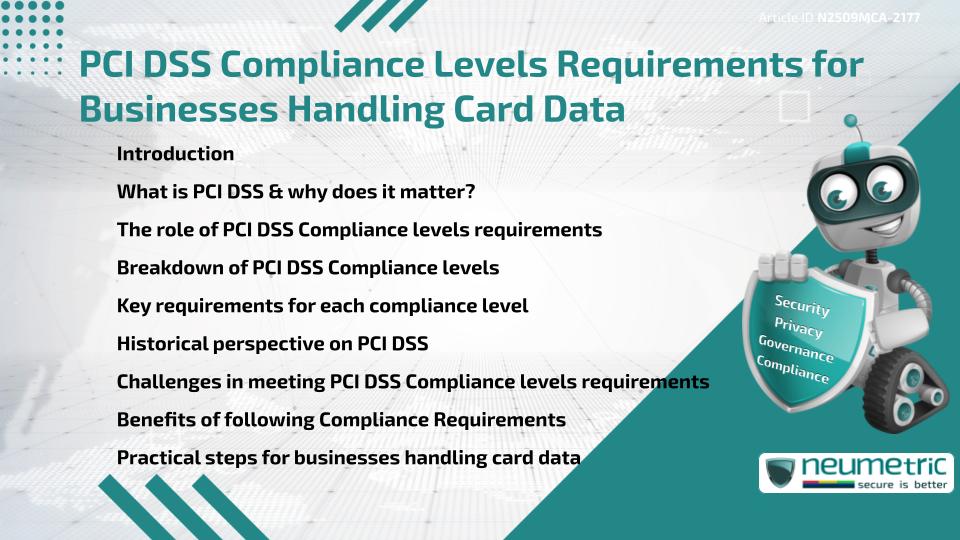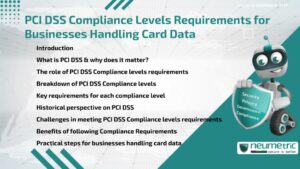Table of Contents
ToggleIntroduction
A PCI DSS Compliance levels requirements checklist provides businesses with clear security expectations when handling Cardholder Data. The Payment Card Industry Data Security Standard [PCI DSS] applies to any organisation that processes, stores or transmits payment card information. Its compliance levels are based on annual transaction volume & each level has specific requirements.
For businesses, understanding & applying PCI DSS Compliance levels requirements ensures they can avoid costly fines, reduce Risk of breaches & maintain Customer Trust. This article explores PCI DSS, its compliance levels, the requirements for each level, challenges, benefits & practical steps toward enterprise readiness.
What is PCI DSS & why does it matter?
PCI DSS is a global Security Framework created to protect Cardholder Information & reduce payment fraud. Established in 2004 by major card brands, PCI DSS ensures businesses safeguard Sensitive Data through uniform security practices.
Failure to comply can result in penalties, lawsuits & reputational harm. More importantly, non-compliance increases the Likelihood of data breaches that compromise Customer Trust.
The role of PCI DSS Compliance levels requirements
The PCI DSS Compliance levels requirements exist to categorize businesses based on transaction volume. This categorization ensures that smaller businesses are not held to the same extensive obligations as large enterprises. At the same time, it provides a clear benchmark for security readiness.
By following these requirements, businesses can demonstrate accountability to regulators, card networks & customers.
Breakdown of PCI DSS Compliance levels
PCI DSS defines four compliance levels:
- Level 1: Over six (6) million annual transactions. Requires annual on-site Audit by a Qualified Security Assessor [QSA].
- Level 2: Between one (1) million & six (6) million transactions. Requires Self-Assessment Questionnaire [SAQ] and possibly additional validation.
- Level 3: Between twenty thousand (20,000) and one (1) million e-commerce transactions annually.
- Level 4: Fewer than twenty thousand (20,000) e-commerce transactions or fewer than one (1) million overall transactions annually.
Each level has different reporting & validation requirements, but the core PCI DSS principles remain the same.
Key requirements for each compliance level
The PCI DSS Compliance levels requirements include:
- Secure network configurations, including firewalls.
- Protection of stored Cardholder Data.
- Encryption of data in transmission across public networks.
- Strong Access Control with unique User identification.
- Ongoing monitoring & Vulnerability management.
- Regular testing of networks & systems.
- Maintenance of formal Security Policies.
For Level 1, businesses must also undergo an annual Audit by a QSA. Levels 2 through 4 can often complete SAQs, though Banks may request additional verification.
Historical perspective on PCI DSS
Before PCI DSS, each payment brand had its own Data Security program. This led to inconsistent & sometimes conflicting requirements. The launch of PCI DSS in 2004 unified these programs into a single, widely accepted standard.
The compliance levels were introduced to recognize that not all businesses face the same Risks or transaction volumes. Since then, PCI DSS has undergone multiple revisions to adapt to new Threats & technologies.
Challenges in meeting PCI DSS Compliance levels requirements
Businesses often face challenges such as:
- Complexity of requirements across distributed systems.
- Lack of internal expertise to manage compliance effectively.
- Resistance from Employees who see compliance as red tape.
- High costs for security infrastructure & audits.
Small Businesses in particular may struggle to balance costs with compliance demands. Nonetheless, using a structured approach makes the process manageable.
Benefits of following Compliance Requirements
Adhering to PCI DSS Compliance levels requirements offers significant benefits:
- Reduced Likelihood of data breaches.
- Enhanced Customer Trust & brand reputation.
- Better preparedness for audits & regulatory scrutiny.
- Avoidance of fines & penalties.
- A foundation for broader Cybersecurity frameworks.
Think of PCI DSS Compliance like a seatbelt in a car. It doesn’t guarantee safety, but it dramatically lowers the Risks when something goes wrong.
Practical steps for businesses handling card data
Businesses can adopt the following steps:
- Perform a Gap Analysis against the PCI DSS Compliance levels requirements.
- Train Employees on security awareness & PCI DSS Policies.
- Implement encryption, firewalls & strong authentication controls.
- Engage a QSA for guidance & audits.
- Regularly update Policies & perform Vulnerability scans.
Resources such as the National Institute of Standards & Technology (NIST) can help businesses integrate PCI DSS with broader security frameworks.
Takeaways
The PCI DSS Compliance levels requirements provide businesses with a clear structure to secure Cardholder Data. While meeting these requirements may be complex, they form an essential foundation for trust, readiness & resilience against fraud.
FAQ
What are the PCI DSS Compliance levels requirements?
They are security expectations that vary depending on the number of transactions a business processes annually.
Do all businesses need to comply with PCI DSS?
Yes, any business that processes, stores or transmits Cardholder Data must comply with PCI DSS.
How often should compliance validation be done?
Validation should occur annually & businesses must update their compliance whenever major changes are made to systems or processes.
Is Level 1 compliance more difficult than other levels?
Yes, Level 1 requires the most extensive reporting & auditing due to higher transaction volumes.
Can Small Businesses comply with PCI DSS?
Yes, Small Businesses must comply but usually through simplified Self-Assessment Questionnaires for Levels 3 & 4.
What happens if a business fails PCI DSS Compliance?
Consequences may include fines, increased transaction fees, reputational harm & loss of the ability to process card payments.
Does compliance eliminate security Risks?
No, compliance reduces Risk but does not eliminate it. Businesses must adopt additional security practices beyond PCI DSS.
Need help for Security, Privacy, Governance & VAPT?
Neumetric provides organisations the necessary help to achieve their Cybersecurity, Compliance, Governance, Privacy, Certifications & Pentesting needs.
Organisations & Businesses, specifically those which provide SaaS & AI Solutions in the Fintech, BFSI & other regulated sectors, usually need a Cybersecurity Partner for meeting & maintaining the ongoing Security & Privacy needs & requirements of their Enterprise Clients & Privacy conscious Customers.
SOC 2, ISO 27001, ISO 42001, NIST, HIPAA, HECVAT, EU GDPR are some of the Frameworks that are served by Fusion – a SaaS, multimodular, multitenant, centralised, automated, Cybersecurity & Compliance Management system.
Neumetric also provides Expert Services for technical security which covers VAPT for Web Applications, APIs, iOS & Android Mobile Apps, Security Testing for AWS & other Cloud Environments & Cloud Infrastructure & other similar scopes.
Reach out to us by Email or filling out the Contact Form…





